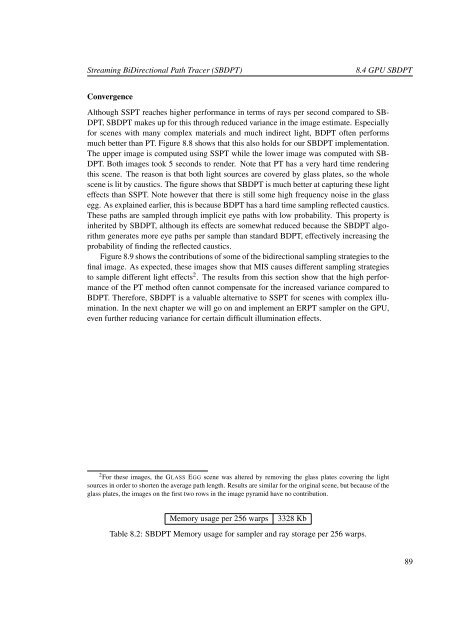Master Thesis - Computer Graphics and Visualization - TU Delft
Master Thesis - Computer Graphics and Visualization - TU Delft
Master Thesis - Computer Graphics and Visualization - TU Delft
You also want an ePaper? Increase the reach of your titles
YUMPU automatically turns print PDFs into web optimized ePapers that Google loves.
Streaming BiDirectional Path Tracer (SBDPT) 8.4 GPU SBDPT<br />
Convergence<br />
Although SSPT reaches higher performance in terms of rays per second compared to SB-<br />
DPT, SBDPT makes up for this through reduced variance in the image estimate. Especially<br />
for scenes with many complex materials <strong>and</strong> much indirect light, BDPT often performs<br />
much better than PT. Figure 8.8 shows that this also holds for our SBDPT implementation.<br />
The upper image is computed using SSPT while the lower image was computed with SB-<br />
DPT. Both images took 5 seconds to render. Note that PT has a very hard time rendering<br />
this scene. The reason is that both light sources are covered by glass plates, so the whole<br />
scene is lit by caustics. The figure shows that SBDPT is much better at capturing these light<br />
effects than SSPT. Note however that there is still some high frequency noise in the glass<br />
egg. As explained earlier, this is because BDPT has a hard time sampling reflected caustics.<br />
These paths are sampled through implicit eye paths with low probability. This property is<br />
inherited by SBDPT, although its effects are somewhat reduced because the SBDPT algorithm<br />
generates more eye paths per sample than st<strong>and</strong>ard BDPT, effectively increasing the<br />
probability of finding the reflected caustics.<br />
Figure 8.9 shows the contributions of some of the bidirectional sampling strategies to the<br />
final image. As expected, these images show that MIS causes different sampling strategies<br />
to sample different light effects 2 . The results from this section show that the high performance<br />
of the PT method often cannot compensate for the increased variance compared to<br />
BDPT. Therefore, SBDPT is a valuable alternative to SSPT for scenes with complex illumination.<br />
In the next chapter we will go on <strong>and</strong> implement an ERPT sampler on the GPU,<br />
even further reducing variance for certain difficult illumination effects.<br />
2 For these images, the GLASS EGG scene was altered by removing the glass plates covering the light<br />
sources in order to shorten the average path length. Results are similar for the original scene, but because of the<br />
glass plates, the images on the first two rows in the image pyramid have no contribution.<br />
Memory usage per 256 warps 3328 Kb<br />
Table 8.2: SBDPT Memory usage for sampler <strong>and</strong> ray storage per 256 warps.<br />
89
















